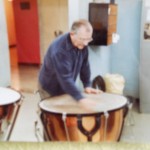My Musical Career|Part Eight
I ended my last blog entry in the Leonia, N.J. studio of my teacher and mentor, Fred. D. Hinger. I had many, many hours of superlative instruction from this gentleman. Mr. Hinger was my principal teacher for four years – from the fall of 1971 until June 1975, when I received my Master’s degree. I chose to stay with him for those four years because I wanted to learn all there was to know about timpani playing from this man – who was an undisputed master of the instrument. He was, as I noted earlier, also an undisputed master of percussion as well. Prior to becoming the Philadelphia Orchestra’s principal timpanist, he was the principal percussionist and assistant timpanist for three years. Prior to that, he was xylophone soloist in the U.S. Navy Band for six years. He had a lot to offer experience wise, and in addition he was the proponent of a different approach to timpani and to some extent, percussion. His approach was different from the normal J-stroke in that with his method one pulled the sound out of the instrument – it somewhat eliminated the extra motion of what I call the attack and emphasized the heart of the stroke, which he called the touch as well of the follow through. The sound of the drum – to my ears at any rate – was much more musical. It allowed the drum to sing rather than to bark.
This approach carried over to the mallets and snare drum as well.
He was tireless in making sure his students understand the essence of what he was teaching, and he would get really excited and his eyes would light up and he would say “That’s it –that’s it!” when you showed by some fine playing that you “got”it. Conversely, when one performed poorly or did not get a good sound – he suffered. I remember one time, in working on the slow movement of Beethoven’s Third Symphony – the “Marche funebre” – I landed too hard on a low G roll – the initial attack was a little too hard for his liking – and he let out a wail of desperation – Nooooooooooo…. so loud that it could be heard upstairs by other students waiting their turn for a lesson, and could probably be heard all the way to Glenwood Avenue.
I was mortified at making such an egregious error and eliciting such a decidedly negative response from my teacher. However, that response lasted only for a minute – he quickly put me to rights and made sure that I knew what was about with regard to the symphony.
Looking back over the incident, I realize how fortunate I was to have an instructor who was so knowledgeable and passionate about what he did and taught and he inspired me to do my best with each lesson. With regard to timpani, I absorbed a very great deal from him and I am pleased to report that we stayed in touch after graduation and that I went back for several refresher lessons over the years. He was also responsible for putting me in touch with the Oslo Philharmonic, but I’ll save that for later.
Percussionwise, I did learn quite a bit from him, but not as much as I would have liked or should have. The fault was more mine than his, as his teaching technique was impeccable and what he had to say was profound. He was miles ahead of me on all the percussion instruments, and I was so much into timpani that I made that my focus and did not concentrate on snare and mallets as much as I should have. He made sure that I had more than a basic grounding on mallets and snare drum, but that is as far as I got. I was intimidated by his vastly superior skills and by the amount of catching-up that I would have to do. Add to that the lack of practice facilities –my commuting from Yorktown got me in to MSM at about 8:30 am – and by then all the practice rooms and instruments were spoken for. The rest of the day’s schedule was given over to classes, and for the most part, when my last class was done, it was time to make the return journey. Looking back on all of this, the Good Lord must have been surely watching over me, for despite these obstacles, I was able to complete my studies and even do a one-year Master’s program as well.
Jury Examinations
Jury Examinations were the way a student was evaluated at the end of each term. Much like an audition today, the student played in front of several faculty members, who served on the jury and evaluated each student’s performance. Typically, a percussion student would be asked to perform a solo on one or more of the three major percussion instruments: timpani, marimba, and snare drum. The atmosphere was very much the same as at an audtion. A marimba and xylophone, snare drum, and a set of timpani were set up in a semi-circle, with music stands and trap tables provided. The student would put his music and mallets out and then start on one instrument – when that selection was finished (more often, it was a selected passage or passages from the solo work in question), the student would move on to the next instrument and repeat the process until the jury decided that they were satisfied with what they had heard. The student then departed the premises while the jury made their evaluations of that particular student. Once finished, the jury summoned the next student.
The complete percussion faculty tried to be present as much as possible, but do to their rehearsal commitments, that was not always possible. At least three faculty members were always present. Mr. Hinger showed up for most of my juries unless he had a Met rehearsal. Usually, it was Jim Priess, Paul Priess, and Morris (Arnie) Lang (and after he left to teach at Brooklyn College, Walter Rosenberger.
The atmosphere around jury times (which occurred at the end of each semester) was frenetic, particularly in the practice room areas. It was next to impossible to get a practice room as all of the percussion students –especially including those who didn’t do a bit of practicing during the semester – came out of the woodwork to cram for the juries. Marimbas and xylophones were scattered in the hallways and landings – the students would poach them from Room 610 and drag them into the hallways. The 5th and 6th floor landings resounded with scales and the Bach A minor Violin Concerto (arr. Goldenberg). If a student practiced timpani in the two studios allotted to timpani practice, they’d pull the mallet instruments out of those studios as well. I found it disturbing to say the least.
I generally did well on the juries – my timpani skills really improving, and I held my own in percussion – barely. To be honest, I didn’t really care much for the percussion, feeling that as a percussionist, I was one of many – whereas as a timpanist, I could stand out much more.
I was nervous, as you might suppose, but I always did my best to get as much practicing as possible, despite the disadvantages of commuting, which I mentioned in an earlier blog post. Juries were always an occasion for the students to dress up for. Very few students went in wearing blue jeans and sneakers. We always had a suit and tie – it was a different era then. In many ways, we respected the school and the music field and we dressed accordingly. One doesn’t go to an interview or audition dressed inappropriately, so why should the jury be any different? I must confess to some amusement at seeing many percussion students who normally looked like they had fallen out of bed dressed to the nines for the day – resuming their normal appearance as soon as the spotlight of the jury was no longer on them.
Once one completed the jury exam, the relief was palpable, and one usually let off steam by going down to the cafeteria and spending an hour or to sitting with friends and comparing notes on “how I nailed “Porgy and Bess” or how I screwed up on “Bolero”. Those were the days!



Recent Comments